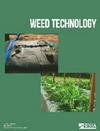Adsorption of spray droplets reduced adsorption of dicamba spray droplets on leaves as droplet size increases
IF 1.3
3区 农林科学
Q3 AGRONOMY
引用次数: 0
Abstract
Off-target movement of growth regulator herbicides can cause severe injury to susceptible plants. Apart from not spraying on windy days or at excessive boom heights, making herbicide applications using nozzles that produce large droplets is the preferred method for reducing herbicide drift. Although large droplets maintain a higher velocity and are more likely to reach the leaf surface in windy conditions, their ability to remain on the leaf surface is poorly understood. Upon impact with the leaf surface, droplets may shatter, bounce, roll-off, or be retained on a leaf surface. We examined how different nozzles, pressures, and adjuvants impact spray droplet adsorption on the leaf surface of common lambsquarters and soybean. Plants were grown in a greenhouse and sprayed in a spray chamber. Three nozzles (XR, AIXR, and TTI) were evaluated at 138, 259, and 379 kPa. Dicamba (0.14 kg ae ha⁻¹) was applied alone and with methylated seed oil (MSO), a non-ionic surfactant, silicone-based adjuvant, crop oil concentrate, or a drift reduction adjuvant. A 1, 3, 6, 8-pyrene tetra sulfonic acid tetra sodium salt was added as a tracer. Dicamba spray droplet adsorption when using the XR nozzle, which produced the smallest spray droplets, was 1.75 times greater than when applied with the TTI nozzle with the largest spray droplets. Applying dicamba with MSO increased adsorption on leaf surfaces nearly four times the amount achieved without an adjuvant. The lowest application pressure (138 kPa) increased dicamba spray volume adsorbed more than 10% compared to the higher pressures 259 and 379 kPa. By understanding the impacts of these application parameters on dicamba spray droplet adsorption, applicators can select application parameters, equipment, and adjuvants that will maximize the amount of dicamba spray volume retained on the target leaf surface while minimizing dicamba spray drift.喷雾液滴的吸附性 随着液滴大小的增加,麦草畏喷雾液滴在叶片上的吸附性降低
生长调节剂除草剂的脱靶移动会对易感植物造成严重伤害。除了不要在大风天喷洒除草剂或喷洒高度过高的除草剂外,使用能产生大液滴的喷嘴喷洒除草剂也是减少除草剂漂移的首选方法。虽然大液滴能保持较高的速度,在有风的情况下更容易到达叶片表面,但人们对其在叶片表面的停留能力了解甚少。液滴撞击叶面后,可能会破碎、反弹、滚落或留在叶面上。我们研究了不同的喷嘴、压力和佐剂如何影响喷雾液滴在普通羔羊草和大豆叶片表面的吸附。植物在温室中生长,并在喷雾室中进行喷雾。在 138、259 和 379 千帕压力下对三种喷嘴(XR、AIXR 和 TTI)进行了评估。麦草畏(0.14 kg ae ha-¹)可单独施用,也可与甲基化种子油 (MSO)、非离子表面活性剂、硅酮类佐剂、作物浓缩油或减少漂移佐剂一起施用。添加了 1,3,6,8-芘四磺酸四钠盐作为示踪剂。使用 XR 喷嘴喷洒麦草畏时,产生的雾滴最小,而使用 TTI 喷嘴喷洒麦草畏时,产生的雾滴最大,其雾滴吸附力是使用 TTI 喷嘴喷洒麦草畏时的 1.75 倍。使用含 MSO 的麦草畏时,叶片表面的吸附量比不使用辅助剂时增加了近四倍。与 259 和 379 千帕的较高压力相比,最低施药压力(138 千帕)增加了麦草畏喷雾吸附量的 10%以上。通过了解这些施药参数对麦草畏喷雾液滴吸附的影响,施药者可以选择施药参数、设备和佐剂,从而最大限度地增加目标叶片表面的麦草畏喷雾量,同时最大限度地减少麦草畏喷雾漂移。
本文章由计算机程序翻译,如有差异,请以英文原文为准。
求助全文
约1分钟内获得全文
求助全文
来源期刊

Weed Technology
农林科学-农艺学
CiteScore
2.90
自引率
21.40%
发文量
89
审稿时长
12-24 weeks
期刊介绍:
Weed Technology publishes original research and scholarship in the form of peer-reviewed articles focused on understanding how weeds are managed.
The journal focuses on:
- Applied aspects concerning the management of weeds in agricultural systems
- Herbicides used to manage undesired vegetation, weed biology and control
- Weed/crop management systems
- Reports of new weed problems
-New technologies for weed management and special articles emphasizing technology transfer to improve weed control
-Articles dealing with plant growth regulators and management of undesired plant growth may also be accepted, provided there is clear relevance to weed science technology, e.g., turfgrass or woody plant management along rights-of-way, vegetation management in forest, aquatic, or other non-crop situations.
-Surveys, education, and extension topics related to weeds will also be considered
 求助内容:
求助内容: 应助结果提醒方式:
应助结果提醒方式:


